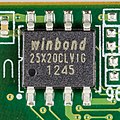Linux
Given the correct device tree, the same compiled kernel can support different hardware configurations within a wider architecture family. The Linux kernel for the ARC, ARM, C6x, H8/300, MicroBlaze, MIPS, NDS32, Nios II, OpenRISC, PowerPC, Power ISA, RISC-V, SuperH, and Xtensa architectures reads device tree information; on ARM, device trees have been mandatory for all new SoCs since 2012. [2] This can be seen as a remedy to the vast number of forks (of Linux and Das U-Boot) that have historically been created to support (marginally) different ARM boards. The purpose is to move a significant part of the hardware description out of the kernel binary, and into the compiled device tree blob, which is handed to the kernel by the boot loader, replacing a range of board-specific C source files and compile-time options in the kernel. [2]
It is specified in a Devicetree Source file (.dts) and is compiled into a Devicetree Blob or device tree binary (.dtb) file (also known as the flattened device tree) [3] through the Devicetree compiler (DTC). Device tree source files can include other files, referred to as device tree source includes. [4] [1]
It has been customary for ARM-based Linux distributions to include a boot loader that necessarily was customized for specific boards, for example Raspberry Pi or Hackberry A10. This has created problems for the creators of Linux distributions as some part of the operating system must be compiled specifically for every board variant, or updated to support new boards. However, some modern SoCs (for example, Freescale i.MX6) have a vendor-provided boot loader with device tree on a separate chip from the operating system. [5]
A proprietary configuration file format used for similar purposes, the FEX file format, [6] is a de facto standard among Allwinner SoCs.
Devicetree is widely used for ARM-based Android devices.

